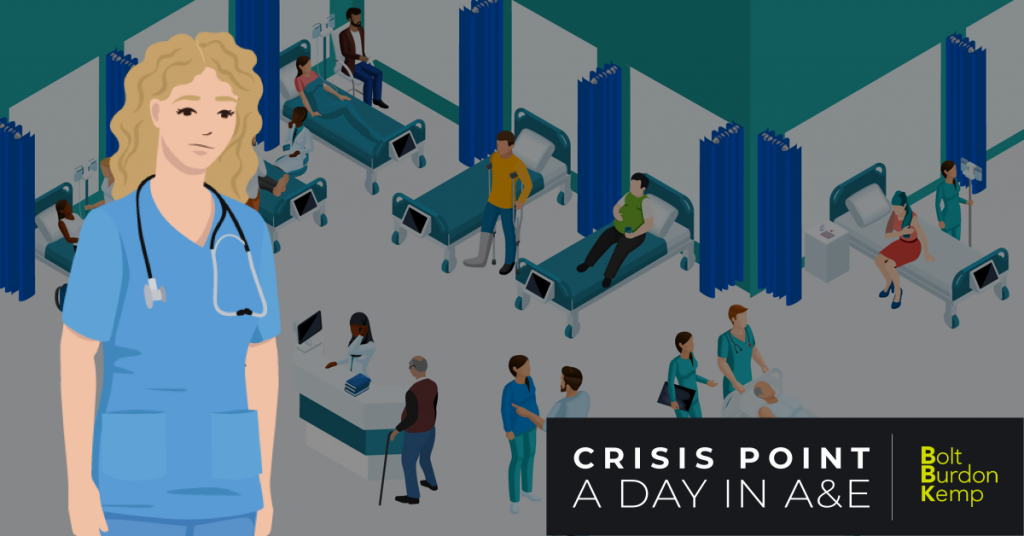Get an insight into the A&E crisis through this interactive challenge
Every year, one of the topics that dominates British headlines is the NHS winter crisis. Used to describe the influx of patients in the colder months, the crisis represents one of the key pressure points faced by NHS staff and management each year. As medical negligence lawyers, we see first-hand the detrimental impact this pressure can have on patients.
As the first port of call for emergency care, the Accident and Emergency departments of hospitals often bear the brunt of the crisis. While A&Es are always busy, extreme weather – cold winters and sweltering summers – often means unprecedented numbers of patients seek medical help. Every year, those numbers rise.
How do the medical professionals and support staff that form the bedrock of the A&E cope with this increasing demand? We interviewed several members of A&E staff* to explore some of the biggest issues, concerns and difficulties they face every year.
Why are patient numbers increasing?
According to the latest statistics[1], an average of 67,000 people attended A&Es in England every day in the first eight months of 2018. This is a 3.9% increase in patients compared to the same period the previous year. Over the last five years, patient numbers in A&Es have risen 7.3%, which amounts to almost 3,000 extra people every day.
There are several reasons why patient numbers are increasing. For one, more people are making use of the medical, health and wellbeing services available to them[2]. Meanwhile, medical advances mean older people are living for longer – some with complicated conditions that may need regular medical attention – and consequently are making more visits to A&E.
Another major factor that A&E staff have to deal with is the impact of extreme temperatures. Bitterly cold winters can exacerbate certain conditions and contribute to an increase in pneumonia and influenza, while unusually hot summers can increase risk of heat stroke and dehydration. “Over the last few of years”, says one of our interviewees, “it doesn’t make a difference whether it’s a winter day or a summer day in terms of taking us to crisis point.”
The problem with NHS funding
As patients increase, the only way A&Es will be able to deliver the same standard of care is by increasing what they have to offer. This means adding more staff, sourcing more beds, securing more equipment and upgrading their facilities. Our A&E interviewees are keen to stress this issue. “We need to have the resource and space to get people through the A&E system properly,” says one of the staff members we interviewed. They add: “The facilities we have now are nowhere near big enough to cope with the increased demand”.
More funding is the obvious answer. In September 2018, the government announced that an extra £145 million in winter funding would be released for 2018/19[3]. However, winter-focused funding has historically made a minimal impact on the performance of A&Es. With funds often only made available as late as the end of November, NHS trusts found it difficult to ensure the most cost-effective (and patient-focused) solutions are put in place for the winter.[4]
The impact of government targets
Another factor that impacts the day-to-day lives of A&E staff is government-imposed targets regarding the handling of patients. In 2004, the government announced that 98% of all patients in A&E need to be assessed, and then admitted or discharged within four hours of entering the department.
Although ambitious, this target failed to account for seasonal pressures, and was lowered to 95% when it became obvious that A&E departments would struggle over the winter. Emergency departments found that several factors – like the number of vacant hospital beds, a lack of consultants to assess patients and the availability of social care support to look after them after they’ve been discharged – inevitably meant patients stayed far longer in A&E than necessary.[5]
And, as our interviewees explained, trying to adhere to these government targets put undue pressure on medical staff. “Treating patients with the care and respect they deserve,” explains one of our interviewees, “becomes increasingly harder when you’re constantly pressured by these numbers.”
In February 2018, NHS England made the decision to scrap the target completely, at least until April 2019, at which time the situation is due to be re-assessed.
Introducing Crisis Point: A Day in A&E, our new interactive challenge
To help highlight the numerous difficulties and pressures faced by those who work in A&E departments across the country, we created an interactive challenge that puts you in the heart of the action. Crisis Point: A Day in A&E takes you into a typical A&E in the UK to show you what it’s like to be on the frontlines of one of the busiest departments of the NHS.
You’ll tackle a typical day in A&E across two 12-hour shifts, making key patient and staffing decisions in a bid to make sure your A&E meets its government targets. Taking turns as a staff nurse, senior sister, senior charge nurse, junior doctor and consultant (with a brief stint as a paramedic), you’ll encounter some of the typical patient cases, medical decisions, and staffing, resource and procedural concerns that challenge A&E staff on a daily basis.
Advocating for a better A&E
One of the main observations we made during our interviews with A&E personnel was their dedication to patient care. Unfortunately, there are various external and internal issues and roadblocks – thanks to government targets, under-resourcing and poor public awareness – that make it difficult for them to do that core part of their job.
More needs to be done – by the government, by public bodies, and by NHS staff themselves – to bring A&E back to what it does best: unparalleled patient advocacy. It’s a sentiment echoed by the A&E staff we interviewed: “We need to go back to patient-centred care or we risk losing the empathy aspect of the doctor-patient relationship.”
Do you need support after medical treatment?
The way doctors, nurses, specialists and support staff handle unprecedented levels of demand speaks volumes about the standard and quality of the medical professionals on which we depend. However, while much of the NHS staff work hard to keep patients healthy and well-looked-after, mistakes can be inevitable.
If you or a loved one has suffered an injury as a result of sub-standard care or medical treatment at any medical facility in the UK, you might be entitled to make a compensation claim. Contact us for a no-obligation chat to discuss your circumstances with one of our highly-trained, specialist medical negligence solicitors.
* Bolt Burdon Kemp would like to extend their gratitude to the members of A&E staff – including senior sisters, staff nurses, junior doctors, consultants and paramedics – whose gracious help was invaluable when creating this piece. The staff were interviewed between September and December 2018.
[1] https://researchbriefings.parliament.uk/ResearchBriefing/Summary/CBP-7281
[2] https://www.kingsfund.org.uk/blog/2018/10/short-history-nhs-winter-funding
[3] https://www.kingsfund.org.uk/blog/2018/10/short-history-nhs-winter-funding
[4] https://improvement.nhs.uk/documents/3201/NHS_review_of_winter_2017.18.pdf
[5] https://theconversation.com/fact-check-are-aande-waiting-times-in-england-the-shortest-in-the-world-40774











